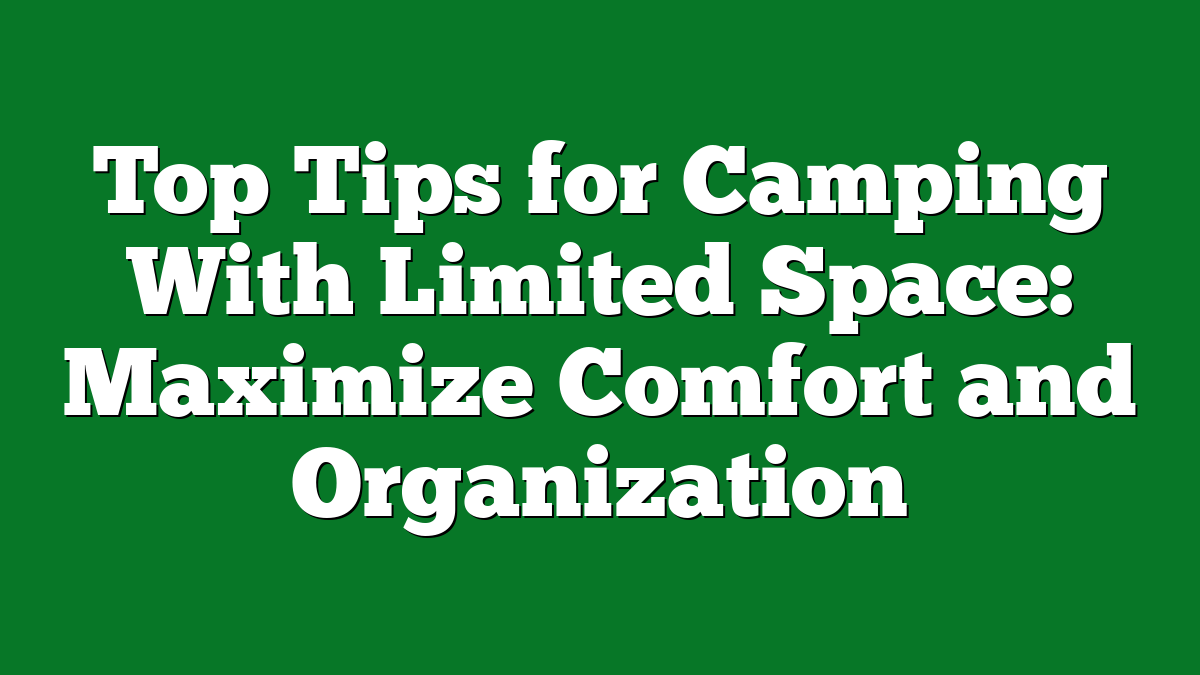Camping can be a thrilling escape into nature, but when you’re working with limited space, it can feel like a puzzle. I’ve been there, trying to fit everything I need into a small backpack or cramped car. It’s all about maximizing what you’ve got and making smart choices that keep your adventure stress-free.
Best Tips for Camping With Limited Space
Maximizing space while camping requires strategic planning and smart packing. Here are my top tips:
- Choose Compact Gear: I always opt for lightweight, compact tents and sleeping bags. These items save space while ensuring comfort and protection. Brands like REI and Big Agnes offer great options.
- Prioritize Multi-Use Items: I bring gear that serves multiple purposes. A hiking pole doubles as a tent stake, and a multi-tool replaces several single-purpose tools. This choice keeps my pack light.
- Use Compression Bags: I pack clothes and sleeping bags in compression bags. These bags reduce bulk and create extra space in my backpack. It’s an easy way to maximize every inch.
- Plan Meals Wisely: I prepare simple, lightweight meals using dehydrated foods. They’re easy to pack and require minimal cooking gear. Items like oatmeal and freeze-dried meals simplify my meal prep.
- Organize Smartly: I categorize my gear into specific packing cubes. This method helps me find essentials quickly and efficiently, preventing clutter in my pack.
- Limit Clothing Choices: I stick to versatile clothing items. Quick-dry fabrics and layering options work well for different weather conditions. This approach means packing fewer items while staying comfortable.
- Utilize Every Available Space: I fill every nook and cranny of my backpack, including pockets and side compartments. This practice ensures no space goes unused.
- Share the Load: When camping with friends, I always discuss gear sharing. Splitting cooking gear or even a tent saves individual space in our packs.
- Leave Non-Essentials Behind: I focus on essentials only. This mindset eliminates unnecessary items like extra shoes or books, allowing me to travel lighter.
These tips streamline my camping experience, making it easy to enjoy the outdoors without feeling cramped.
Evaluate Your Gear
Evaluating gear is crucial when camping with limited space. Picking the right equipment can make a massive difference in comfort and convenience.
Choosing Lightweight Equipment
Choosing lightweight equipment simplifies packing. I prefer gear made from materials like titanium and ultralight nylon. For example, a lightweight tent takes up minimal space without sacrificing durability. A 2-pound sleeping bag compresses easily, fitting snugly into my backpack. I focus on items that pack down small, ensuring I carry only what’s essential. Every ounce counts when space is tight.
Multi-Functional Tools
Multi-functional tools maximize utility and minimize bulk. I often carry a multi-tool that includes pliers, a knife, and screwdrivers. This one item replaces several tools, reducing the need for extra space. Cooking with a pot that doubles as a pan saves room and weight. Additionally, a collapsible water bottle is versatile for different activities and takes up minimal space. Each choice I make enhances both functionality and efficiency.
Packing Strategies
I understand the challenge of camping with limited space. Utilizing effective packing strategies can make a huge difference in your outdoor experience. Here are some tips that I’ve found helpful over the years.
Rolling vs. Folding Clothes
Rolling clothes instead of folding them maximizes space in your pack. Rolling prevents wrinkles and allows you to fit more items into tight spots. I often roll socks, t-shirts, and even lightweight pants. Each rolled item can slide easily into gaps between other gear, making it easier to organize. Folding can take up unnecessary space, especially with bulkier items. Choose rolling for better efficiency on your next trip.
Using Compression Sacks
Compression sacks are one of my go-to tools for saving space. These sacks reduce the volume of sleeping bags, jackets, or other bulky gear. I use compression sacks to pack items tightly, which cuts down on wasted space in my pack or car. Look for durable, waterproof options to keep your gear dry. Always remember to pack the heaviest items close to your back for better weight distribution. Using compression sacks not only maximizes space but keeps everything organized and accessible.
Space-Saving Solutions
Finding ways to create space while camping enhances comfort and enjoyment in the great outdoors. I’ve discovered some effective solutions that keep my gear organized and my pack light.
Compact Cooking Gear
Opting for compact cooking gear simplifies meal prep and reduces bulk. I rely on a nesting cookware set, which includes pots and frying pans that stack neatly inside each other. A lightweight camping stove, like a canister stove or a pocket rocket, fits easily into tight spaces and cooks meals quickly. I also carry a multi-functional utensil that combines a fork, spoon, and can opener, cutting down on the number of items I need. Using dehydrated meals saves on both weight and space, fitting perfectly into small bags for easy storage.
Smart Storage Ideas
Smart storage utilizes every inch of available space. I like to use packing cubes for organizing clothing and gear, separating items by category for quick access. Dry bags keep my clothes and food safe from moisture, and they compress well into small areas. I also repurpose items like empty water bottles for storing toiletries or small tools, ensuring I’m using every piece of available space efficiently. Designating specific pockets in my pack for essential gear, like a first aid kit and headlamp, prevents rummaging through my entire pack for items I need immediately. Storing heavier items close to my back keeps balance and makes trekking easier.
Setting Up Camp
Setting up camp efficiently makes a huge difference when dealing with limited space. It sets a positive tone for the entire outdoor experience. Here’s how I maximize my campsite to ensure comfort and accessibility.
Efficient Tent Arrangement
I always position the tent to make the best use of available space. I first assess the terrain for flat, dry ground and protection from wind. I then orient the tent entrance toward the sunrise for a pleasant wake-up. Keeping the area clear of rocks and debris prevents discomfort and potential damage to gear. Inside, I designate specific zones for sleeping and gear storage. I use my sleeping pad to create a comfortable sleeping area and pack a lightweight hammock for lounging, which adds comfort without taking up much space. This arrangement enhances my camping experience by keeping everything organized.
Utilizing Vertical Space
I look to utilize vertical space wherever possible. I hang items like cooking gear and backpacks from tree branches using carabiners or straps. This keeps the ground area clear and prevents tripping hazards. Using compact shelving units or hanging organizers inside the tent helps store small items effectively. I also hang a gear loft from the tent ceiling for easy access to essentials like headlamps and first-aid kits. Hanging dry bags or using a multi-tiered mesh organizer keeps food and cooking supplies within reach while preserving floor space. By taking advantage of verticality, I create a more spacious environment, allowing me to enjoy the great outdoors to the fullest.
Conclusion
Camping with limited space doesn’t have to be a hassle. By making smart choices and getting a bit creative I’ve found that I can enjoy my outdoor adventures without feeling cramped. It’s all about prioritizing what you really need and finding ways to maximize every inch of space.
Whether it’s rolling clothes or using compression bags I’ve learned that organization is key. With the right gear and a little planning I can keep my camping experience comfortable and enjoyable. So next time you’re packing for a trip remember that a little thought can go a long way in making the most of your limited space. Happy camping!











